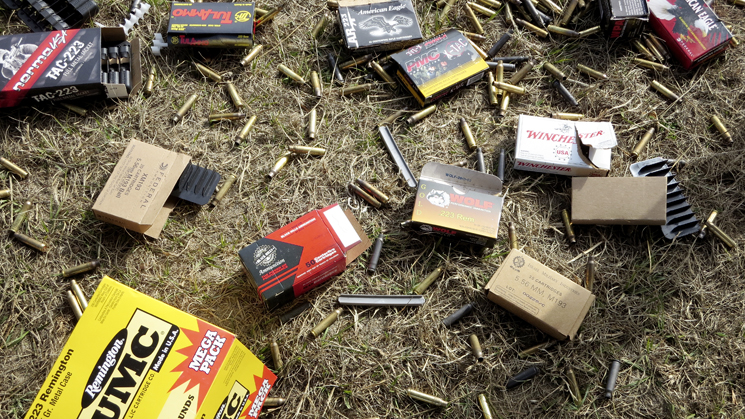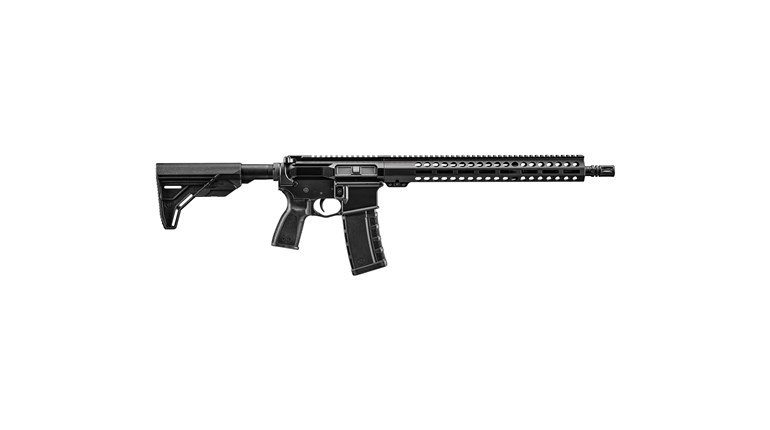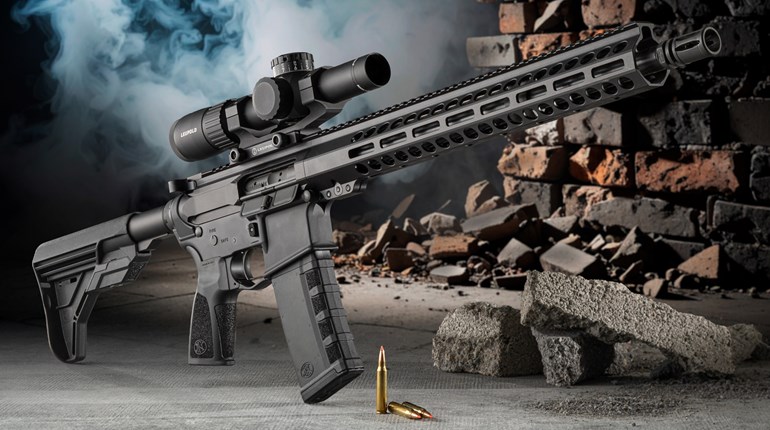
When it comes to 5.56 NATO/.223 Rem. ammunition, 55-grain FMJ is far and away the most popular load used by semi-automatic rifle shooters. Thankfully, it is generally inexpensive and readily available. Target and competitive shooters consume 55-grain FMJ by the caseload for close-range and general purpose shooting and nearly every centerfire rifle ammo manufacturer is turning out its own version of the old M193 Ball cartridge. I use cheap 55-grain FMJ loads for the early break-in phase of my 5.56 NATO-barreled guns and occasionally I see accuracy in the ½ to ¾ minute of angle (MOA) range at 100 yards. But I think it’s safe to say this ammunition is no one’s first choice for precision work.
A recent conversation with a friend centered on whether or not a particular brand of budget-priced 5.56 NATO 55-grain FMJ was worth buying in bulk. Specifically, he wanted to know if one brand could be counted on for decent accuracy and reliability over others. That prompted me to gather up a few of the M193 posers and give them a simple shake out to see if one stood above the others. I bought samplings of twelve different loads—far from the total number of brands available—to put through the plinking paces.
Since this is not match ammo, I devised a simple test that replicated the type of plinking many of us do with target loads. I abandoned our standard five group slow fire test and my usual reliance on a scoped tack driver in favor of a 20-round “plinkuracy” test followed by a 40-round function test. The platform was my own flyweight, 5.56 NATO-chambered Hoplite carbine topped with a Mepro-21 reflex sight. This rugged optic has a 12-MOA amber triangle reticle that is illuminated by tritium and a fiber-optic window. I have found that using the tip of the triangle allows me to keep my groups under 1 MOA at 100 yards, using good quality match ammunition. I figured that a plinking evaluation ought to be done with a plinking gun.
My test methodology for these 5.56 NATO rounds was pretty simple. I fired a five-round slow fire group, followed by a five round rapid string at 100 yards, catching velocities for those ten rounds with an Oehler 35P chronograph. I then fired five rounds each at a 24-inch square steel target at 200 yards and a full 39-inch Iron Maiden at 300 yards. The 100 yard groups were fired from a bench, over a bag rest. The 200 and 300 yard shots on steel were fired from the bench with no bag rest, using only my elbows for support. After all twelve loads had been tested this way, I fired 20 rounds of each type through the little carbine as quickly as I could manipulate the Geissele SD-E flat trigger, standing 25 yards from the target line.
The gun started out clean and lubricated but received no further maintenance during the test. The pencil-thin barrel was allowed to cool for 1 minute between ammo types during the measured group testing. Loads are ranked below in order of downrange performance. While all metrics are important, hits on target matter most, so I gave the highest marks to ammunition that grouped well in slow fire and that had the most hits at 200 and 300 yards. Velocities and 100 yard rapid strings carried the least weight. This test was far from scientific and admittedly there was a fairly decent margin of shooter error possible here, but hey, this is target ammo after all.

I found it interesting that lower SD values did not necessarily correlate to a higher ranking downrange. While counter-intuitive, it demonstrates that bullets moving at similar speeds have other obstacles to overcome in order to make consistent hits. Variations in projectile quality alone within each ammo type can make a big difference in terms of accuracy. You’ll also notice that the three most expensive loads placed in the top five in terms of performance. While not always a guarantee of quality, this may well be a good case of getting what you pay for. Black Hills Ammunition’s .223 Rem. load was the best overall. This stripper clip-loaded ammunition comes in 50-round boxes and is capable of very respectable accuracy, which is not altogether surprising given the quality of their entire fleet of products. Since completing this test I have fed this same Black Hills load through a dozen precision carbines using a good magnified scope. The results have been astounding—sub ¾ MOA is the norm and several rifles have printed sub-½ MOA groups with this particular “target fodder."
All in all each load did what was asked of it. No malfunctions were encountered across all ammunition types. My Hoplite needed a good cleaning after 480 rounds but was none the worse for wear. No high pressure signs were noted on casings and they all landed in the same general area. Although I did not get to test every 5.56 NATO 55-grain FMJ load out there, I feel confident that any brand from the types I did test is good enough to handle basic plinking and close range training tasks.
Ammunition Tested
Black Hills Ammunition .223 Rem. 55-grain FMJ
Wolf WPA Polyformance .223 Rem. 55-grain FMJ (steel case)
Winchester 5.56mm 55-grain FMJ
TulAmmo .223 Rem. 55-grain FMJ (steel case)
Norma USA .223 Rem. 55-grain FMJ
Wolf (WPA) Gold .223 Rem. 55-grain FMJ (brass case)
Federal Ammunition XM193 5.56mm M193 Ball
PMC XP 193 5.56mm 55-grain FMJ
American Eagle .223 Rem. 55-grain FMJ
Remington UMC .223 Rem. 55-grain MC
Israeli Military Industries 5.56mm M193
American Eagle .223 Rem. 55-grain FMJ-BT






































